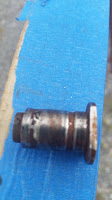It turns out that the open top of the mast (turned 90 degrees to face aft) is a choice nesting spot for some species of bird. That explains the source of the debris I kept finding in the bilge...it dropped down through the mast.
Debris at base of the mast.
 |
| Roughness on the underside of the spreaders could be from galvanic corrosion. They are aluminum and may not be properly isolated from the carbon fiber mast. |
Groves are wearing in the clevis pin for the forestay where it passes through the fitting at the top of the mast.
The Harken Battcars do not slide easily. I tried cleaning them with warm soapy water and then vinegar. That seemed to help some, but still some resistance. Now I know why the main did not drop easily. Paul will pull one of the cars to take a look at the bearings.
I also worked on the rope clutches some more...this time with warm soapy water. Most of them now seem to work fine, but still need to get a couple of them to close consistently. Paul suggested I try ammonia.
 |
| While there, they lifted the boat to check on the centerboard and well. They were pretty clean, but power washed to clean some more. |
 |
| Looking inside the well, I could see small barnacles attached to the pennant. I am going to have the yard replace the pennant while they have the mast out. |
While the boat was lifted, Paul took a look at the keel/hull joint.
 |
| After cutting away the 5200, the gap is still apparent at the aft end of the keel/hull joint. |
 |
| The rest of the keel seemed much tighter against the keel, but Paul found a few places where he could insert a blade a bit. |












